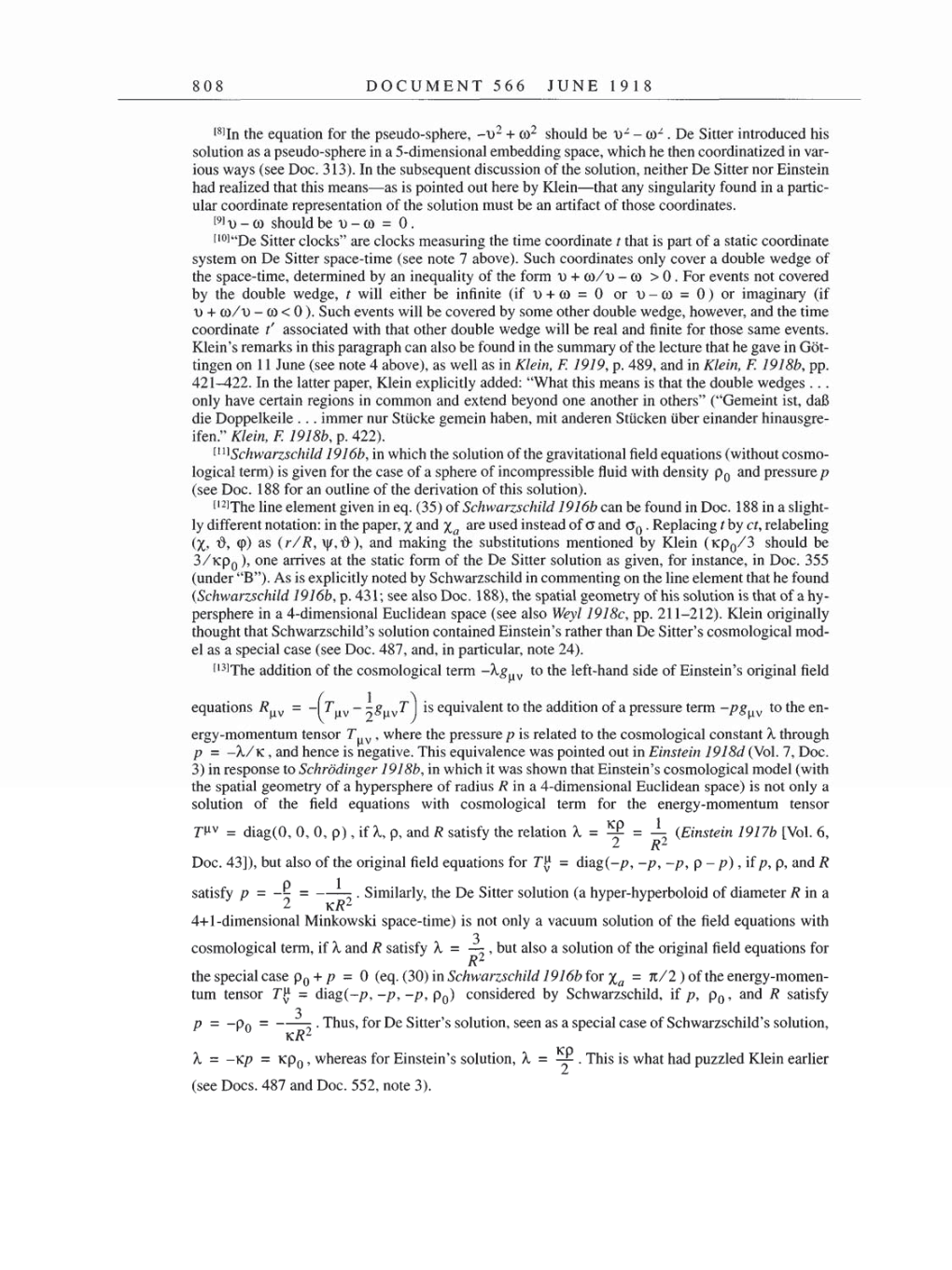808 DOCUMENT 566 JUNE 1918
[8]In
the
equation
for the
pseudo-sphere,
-v2
+
w2
should be
v2
-
w2.
De Sitter introduced his
solution
as a pseudo-sphere
in
a
5-dimensional
embedding space,
which he then coordinatized in
var-
ious
ways
(see
Doc.
313).
In the
subsequent
discussion
of
the
solution,
neither De
Sitter
nor
Einstein
had realized
that this
means-as
is
pointed
out
here
by
Klein-that
any
singularity
found in
a partic-
ular coordinate
representation
of
the solution
must
be
an
artifact
of
those coordinates.
[9]1)
-
©
should be
u
-
©
=
0.
[10]“De
Sitter clocks"
are
clocks
measuring
the time coordinate
t
that
is
part
of
a
static coordinate
system on
De Sitter
space-time
(see note 7 above).
Such coordinates
only cover a
double
wedge
of
the
space-time,
determined
by an inequality
of
the form
u +
w/o
-
©
0.
For events
not
covered
by
the double
wedge,
t
will either be infinite (if
u
+
©
=
0
or
t)
-
©
=
0
)
or imaginary
(if
t) +
w/v
-
©
0
).
Such
events
will be covered
by some
other double
wedge,
however,
and the time
coordinate
t'
associated with that other double
wedge
will be real and finite for those
same
events.
Klein's
remarks in this
paragraph can
also be found in the
summary
of
the lecture that he
gave
in Got-
tingen on 11
June
(see
note
4
above),
as
well
as
in
Klein, F. 1919,
p.
489,
and in
Klein, F. 1918b,
pp.
421-422.
In the latter
paper,
Klein
explicitly
added: "What this
means
is that
the double
wedges
...
only
have certain
regions
in
common
and extend
beyond one
another in others" ("Gemeint
ist,
daß
die
Doppelkeile
...
immer
nur
Stücke
gemein
haben,
mit
anderen Stücken über einander
hinausgre-
ifen."
Klein, F. 1918b,
p.
422).
[11]Schwarzschild
1916b,
in which the solution
of
the
gravitational
field
equations
(without
cosmo-
logical
term)
is
given
for the
case
of
a sphere
of
incompressible
fluid with
density
p0
and
pressure
p
(see
Doc. 188
for
an
outline
of
the derivation
of
this
solution).
[12]The
line element
given
in
eq.
(35)
of
Schwarzschild 1916b
can
be found in Doc. 188 in
a slight-
ly
different notation: in the
paper,
x
and
xa
are
used instead
of
o
and
o0.
Replacing
t
by
ct,
relabeling
(X,
ô,
p)
as
(r/R,
\]/,i3),
and
making
the
substitutions mentioned
by
Klein
(Kp0/3
should be
3/Kp0),
one
arrives
at
the static form
of
the De Sitter solution
as given,
for
instance,
in Doc. 355
(under "B").
As is
explicitly
noted
by
Schwarzschild in
commenting on
the line element that he found
(Schwarzschild 1916b,
p.
431;
see
also Doc.
188),
the
spatial geometry
of
his solution is that
of
a
hy-
persphere
in
a
4-dimensional Euclidean
space
(see
also
Weyl
1918c,
pp.
211-212).
Klein
originally
thought
that Schwarzschild’s solution
contained
Einstein’s rather than De Sitter’s
cosmological
mod-
el
as a
special
case
(see Doc.
487,
and, in
particular, note 24).
[13]The
addition
of
the
cosmological term
-Ag^v
to
the left-hand
side
of
Einstein’s
original
field
equations
Ruv =
-(Tuv-1/2guvT)
is
equivalent
to
the addition
of
a pressure
term -pg[lv
to
the
en-
ergy-momentum tensor
Tuv,
where the
pressure
p
is
related
to
the
cosmological constant
A
through
p
=
-A/k
,
and hence is
negative.
This
equivalence was pointed
out
in
Einstein 1918d
(Vol.
7, Doc.
3)
in
response
to Schrödinger 1918b,
in which it
was
shown that Einstein’s
cosmological
model
(with
the
spatial geometry
of
a hypersphere
of
radius
R
in
a
4-dimensional Euclidean
space)
is
not
only a
solution
of
the field
equations
with
cosmological
term
for the
energy-momentum
tensor
Tuv
=
diag(0,
0, 0,
p), if
A,
p,
and
R
satisfy
the relation
A
=
kp/2
=
1/R2
(Einstein
1917b
[Vol. 6,
Doc.
43]),
but also
of
the
original
field
equations
for
Tuv
=
diag(-p,
-p,
-p, p
-
p), if
p,
p,
and
R
satisfy
p
=
-p/2
=
1/kR2.
Similarly,
the De
Sitter solution
(a hyper-hyperboloid
of
diameter R
in
a
4+1-dimensional Minkowski
space-time)
is
not
only a vacuum
solution
of
the field
equations
with
cosmological term,
if
A
and
R
satisfy A
=
3/R2
,
but also
a
solution
of
the
original
field
equations
for
the
special case p0 +
p
=
0
(eq.
(30)
in Schwarzschild 1916b for
xa
=
jc/2) of
the
energy-momen-
tum tensor
Tuv
=
diag(-p,
-p, -p,
p0)
considered
by
Schwarzschild,
if
p,
p0,
and
R
satisfy
p
=
-p0
=
-3/kR2.
Thus,
for De Sitter’s solution,
seen as a special case
of
Schwarzschild’s
solution,
A
=
-Kp
=
Kp0,
whereas for
Einstein’s
solution, A
=
kp/2.
This is what had
puzzled
Klein
earlier
(see
Docs. 487 and Doc. 552,
note
3).
